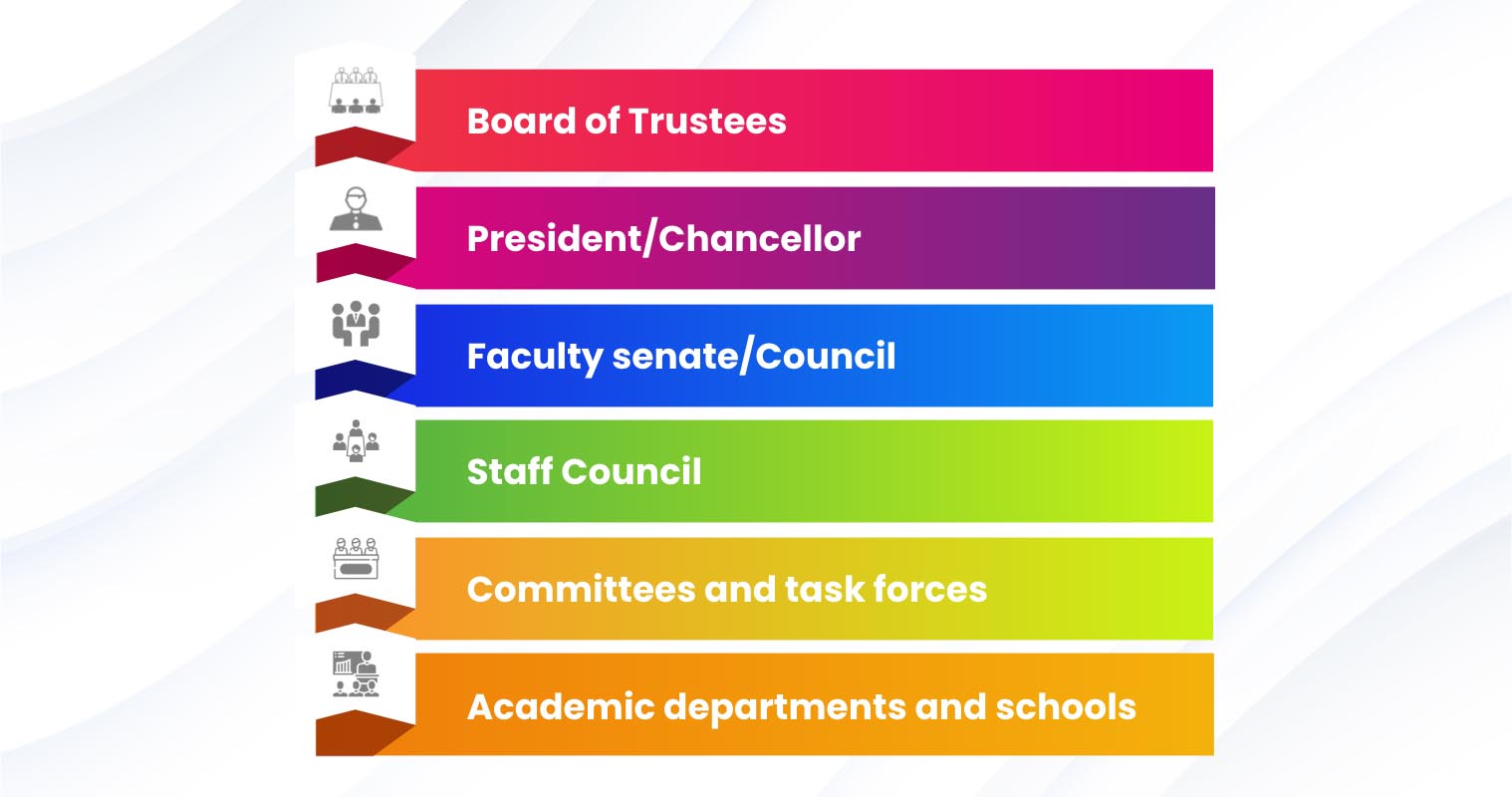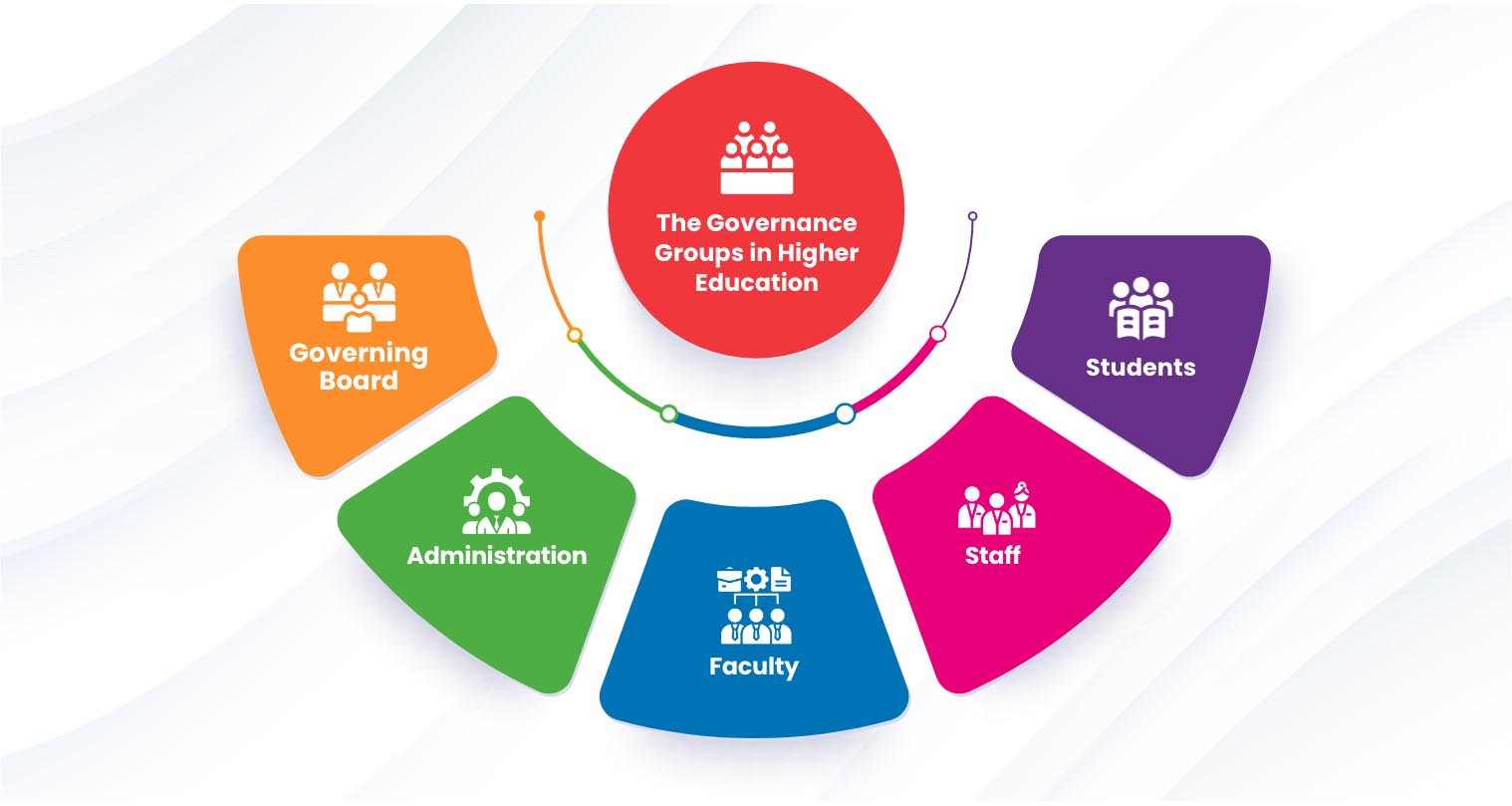Due to the increasing pressure to efficiently administer higher education institutions, the practice of shared governance is receiving more attention than ever. Some political leaders and boards of trustees argue that sharing authority abolishes their right to make big decisions, as someone who knows what’s best for the institutions.
On the other hand, institutions and labor unions like the American Federation of Teachers tout that all college and university employees should have a voice in institutional decisions. These include top-tenured and junior faculty, classified and support staff, and even professional staff with or without faculty rank.
The complexity of tasks in higher education creates an inevitable interdependence among the governing boards, administration, and faculty. This calls for joint effort and the opportunity to collaborate, making shared governance necessary.
While it values the perspectives of faculty and staff, shared governance is not always well-understood by key participants. Explore below how shared governance can help higher education institutions in attaining their missions and goals.
What is Shared Governance in Higher Education
Shared governance in higher education is a collaborative decision-making process that involves sharing authority, responsibility, and accountability among various stakeholders. This approach recognizes the unique knowledge, expertise, and perspectives of faculty, staff, administrators, and students, and aims to ensure that all stakeholders have a voice in decision-making processes.
To formalize shared governance, institutions establish governance structures such as committees, councils, and task forces. These structures are responsible for developing policies and making decisions that affect the academic and administrative aspects of the institution. The goal of shared governance is to foster a culture of collaboration and shared responsibility that supports the institution’s mission and values.
Benefits of Shared Governance in Higher Education

Upholding shared governance within the institution can result in remarkable benefits. Read on to understand why shared governance is fundamental to higher education and how institutions and their faculty unions can benefit from it.
Greater Faculty and Staff Engagement
As shared governance allows faculty and staff to be actively involved in institutional decisions, it also fosters a culture of collaboration and engagement. This leads to a greater sense of ownership and investment in the institution, which in turn, enhances job satisfaction and motivation. When faculty and staff feel valued and have a voice in shaping policies, they are more likely to be committed to the institution’s goals and contribute expertise toward its success.
Enhanced Academic Quality
Shared governance ensures that decisions related to curriculum development, program review, and academic standards are made collectively by faculty and academic administrators. This promotes academic excellence and rigor, as decisions are based on a broad range of perspectives and expertise. As front-liners in teaching and research, the faculty can give valuable insights into best practices and emerging trends in their respective disciplines. This can lead to a higher quality of education for students.
Improved Decision-Making
Shared governance brings together diverse stakeholders, including faculty, staff, students, and administrators, in the decision-making process. This prevents a top-down approach to decision-making and encourages multiple perspectives. Shared governance allows for debates and deliberations that lead to well-informed decisions, which are accepted and implemented by the entire institution.
Increased Innovation and Creativity
Another benefit of shared governance is that it encourages an open exchange of ideas and promotes a culture of innovation and creativity. When faculty, staff, and students have the freedom to express their opinions, it fosters an environment where new initiatives and approaches can be explored. This can lead to the development of innovative programs, research collaborations, and creative solutions to challenges faced by the institution.
Enhanced Trust and Collegiality
Shared governance promotes trust and collegiality, recognizing and valuing the expertise and contributions of all groups. Faculty, staff, and students feel respected and included in decision-making, building trust, and fostering a positive working environment. This approach encourages meaningful relationships, leading to greater understanding, cooperation, and shared commitment to the institution’s mission and vision.
By implementing shared governance, higher education institutions can foster trust and collaboration among stakeholders. Value the expertise and contributions of your stakeholders and reap these benefits in return.
Critical Factors for a Shared Governance Model
A shared governance model in higher education involves the participation of various stakeholders, including faculty, staff, students, and administrators, in the decision-making process. Listed here are key factors that contribute to the successful implementation of a shared governance model in colleges and universities:
- Inclusivity — This involves the active participation of relevant stakeholders in decision-making. It ensures that everyone is empowered to contribute their opinions and ideas. Inclusivity fosters diversity of thought, cultivates a culture of respect, and ensures that decisions align with the institution’s collective needs and interests.
- Transparency — This fosters openness and accountability that encourages stakeholders to be responsible for their actions and decisions. It involves access to pertinent information and sharing of decision-making processes and outcomes. Transparency helps cultivate trust among stakeholders and promotes a clear understanding of how institutional decisions are made.
- Collaboration — This encourages stakeholders to work together towards common goals. Collaboration involves engaging in meaningful discussions, valuing diverse perspectives, and fostering teamwork. It promotes collective ownership of decisions, constructive engagement, and a culture of cooperation, resulting in effective governance practices.
- Responsiveness — This involves timely and effective responses to the needs and concerns of stakeholders. Responsiveness also emphasizes active listening to feedback, addressing issues, and taking proactive and constructive actions.
- Consensus-Oriented — This involves considering diverse viewpoints and achieving compromise through robust discussions and impartial mediation. Public hearings, forums, and citizens’ right to petition leaders help achieve consensus. Good governance prioritizes agreement from diverse perspectives for the benefit of the entire community.
- Equity — This allows all stakeholders to have equal opportunities to participate, contribute, and benefit from decision-making processes, regardless of their background or position. It promotes inclusivity, diversity, and a culture of respect, where all voices are valued and considered. Equity in governance prevents bias or discrimination, fostering a fair and inclusive environment.
Effective implementation of a shared governance model relies on these critical factors. With these elements in place, higher education institutions can arrive at an effective decision-making process and achieve their goals.
Delegation of Authority and Responsibilities

Delegation of authority and responsibilities helps promotes positive decision-making and empowers stakeholders of the institution. Here are some examples of the division of authority in a higher education institution:
- The Board of Trustees is typically responsible for the overall governance and strategic direction of the institution. They may delegate authority to the President/Chancellor to manage the day-to-day operations of the institution, make financial decisions, and implement policies and procedures.
- The President/Chancellor is responsible for the day-to-day management and administration of the institution. They may delegate authority to senior administrators, such as vice presidents or deans, to oversee specific areas such as academic affairs, finance and budget, student affairs, and human resources.
- The faculty senate/council may have authority over academic policies, curriculum development, faculty hiring and promotion, and other academic affairs. They may also review and recommend changes to institutional policies and procedures related to faculty governance.
- The staff council may be delegated authority over matters related to staff policies, benefits, working conditions, and professional development. They may have responsibilities in advocating for staff interests and providing input on policies and practices that impact staff members.
- Committees and task forces may be given authority to address specific governance areas. For instance, a finance committee may review and make budget recommendations, while a diversity and inclusion committee may develop initiatives for campus diversity, equity, and inclusion.
- The academic departments and schools may have authority over curriculum development, faculty hiring and promotion, and other academic program matters. They are responsible for aligning policies and procedures with the institution’s academic goals and objectives and implementing them effectively.
Delegation of authority and responsibilities may vary depending on the institution’s governance structures, policies, and procedures. The extent of delegated authority may also depend on the legal and regulatory requirements governing higher education in a particular region or country.
The Governance Groups in Higher Education

In the above-mentioned stakeholders, the governance triad—the board, the president, and the faculty—is mainly in charge of managing the entire institution. Some universities establish additional governance groups that involve the staff and students in the decision-making processes.
Learn below the roles and responsibilities of these stakeholders as governance groups of their institutions.
- Governing Board: The Governing Board, or Board of Trustees, is the highest authority in a higher education institution. They set the strategic direction, make policy decisions, oversee finances, and ensure mission, vision, and values are upheld. Their role brings diverse expertise to the institution’s sustainability and success.
- Administration: The higher education administration, including the president, vice presidents, and deans, oversee day-to-day operations. They implement board policies, manage budgets and resources, oversee departments, and ensure the overall functioning of the institution. They play a critical role in achieving strategic goals and promoting leadership.
- Faculty: Faculty are essential academic personnel in higher education, responsible for teaching, research, and service. They help shape the curriculum, develop academic policies, and maintain standards. They participate in shared governance and advance the institution’s academic mission through their teaching, research, and service.
- Staff: Staff members provide vital support for the academic and administrative operations of the institution. They work in diverse areas such as admissions, student services, finance, human resources, facilities management, and IT. They also help in implementing institutional policies and providing essential services to students, faculty, and other stakeholders.
- Students: Students are key beneficiaries of higher education institutions. Their perspectives and needs are crucial in governance. They participate through student government associations, providing input on student life or education quality, advocating for their interests, and contributing to the campus community.
The importance of these groups lies in their collective contributions to effective governance in higher education institutions. Each group brings unique perspectives, expertise, and insights — all crucial for making informed decisions and ensuring that the institution’s mission and values are upheld.
Best Practices of Shared Governance in Higher Education
The Association of Governing Boards of Universities and Colleges considers shared governance as a driver of necessary change for higher education institutions. But despite the solid attention many institutions devoted to shared governance, many key participants still struggle to practically implement it.
Below are the best practices for the implementation of shared governance that every institution should know.
- Clearly define the functions of stakeholders — Establishing clear roles and responsibilities for each stakeholder is crucial to ensure that everyone understands their roles in the shared governance process. This helps to avoid confusion, conflicts, and duplication of efforts and enables effective collaboration.
- Foster a culture of inclusivity and respect — Shared governance requires a culture of inclusivity and respect, where all stakeholders feel valued, heard, and respected. Encourage open and honest communication that values input from all stakeholders, regardless of their position or title. This creates a positive and collaborative environment that fosters trust and encourages participation.
- Provide opportunities for training and professional development — This ensures that stakeholders have the necessary knowledge, skills, and understanding of the shared governance process. Such opportunities include workshops, seminars, and other learning programs that can help stakeholders build their capacity for effective participation in shared governance.
- Establish a clear decision-making process — This should outline how decisions are made, who has the authority to make decisions, and how input from different stakeholders is taken into account. The decision-making process must be transparent and inclusive, ensuring that all stakeholders have the opportunity to provide their input.
- Foster collaboration and consensus-building — Shared governance is built on collaboration and consensus-building, rather than top-down decision-making. Stakeholders should work together collaboratively, seeking common ground, and finding solutions that are acceptable to all parties. This builds trust, encourages active participation, and leads to better decision-making outcomes.
- Ensure accountability and transparency — All stakeholders should be held accountable for their roles and responsibilities, and there should be clear documentation of decisions, rationale, and outcomes. This helps to ensure that decisions are made in a fair and transparent manner, and that stakeholders can trust the process.
- Encourage continuous improvement — Shared governance is a dynamic process that requires a culture of continuous improvement. Encouraging stakeholders to propose changes and implement innovations in the shared governance process helps ensure that it remains effective and relevant in a changing higher education landscape.
By following these best practices, institutions can ensure that their shared governance processes are transparent, inclusive, and responsive to the needs of all stakeholders, leading to improved overall governance of the institution.
Convene: The Modern Solution for Board Governance

In upholding shared governance, institutions require a platform that can help enable effective decision-making and transparency. Convene, a modern board governance solution, provides extensive board management tools that foster the seamless exchange of ideas and perspectives between stakeholders.
With remote accessibility, advanced document management, and collaborative tools, Convene simplifies operations and fosters transparency for institutions. Book a free demo now and discover how Convene can help your institution in implementing shared governance.
Jielynne is a Content Marketing Writer at Convene. With over six years of professional writing experience, she has worked with several SEO and digital marketing agencies, both local and international. She strives in crafting clear marketing copies and creative content for various platforms of Convene, such as the website and social media. Jielynne displays a decided lack of knowledge about football and calculus, but proudly aces in literary arts and corporate governance.











